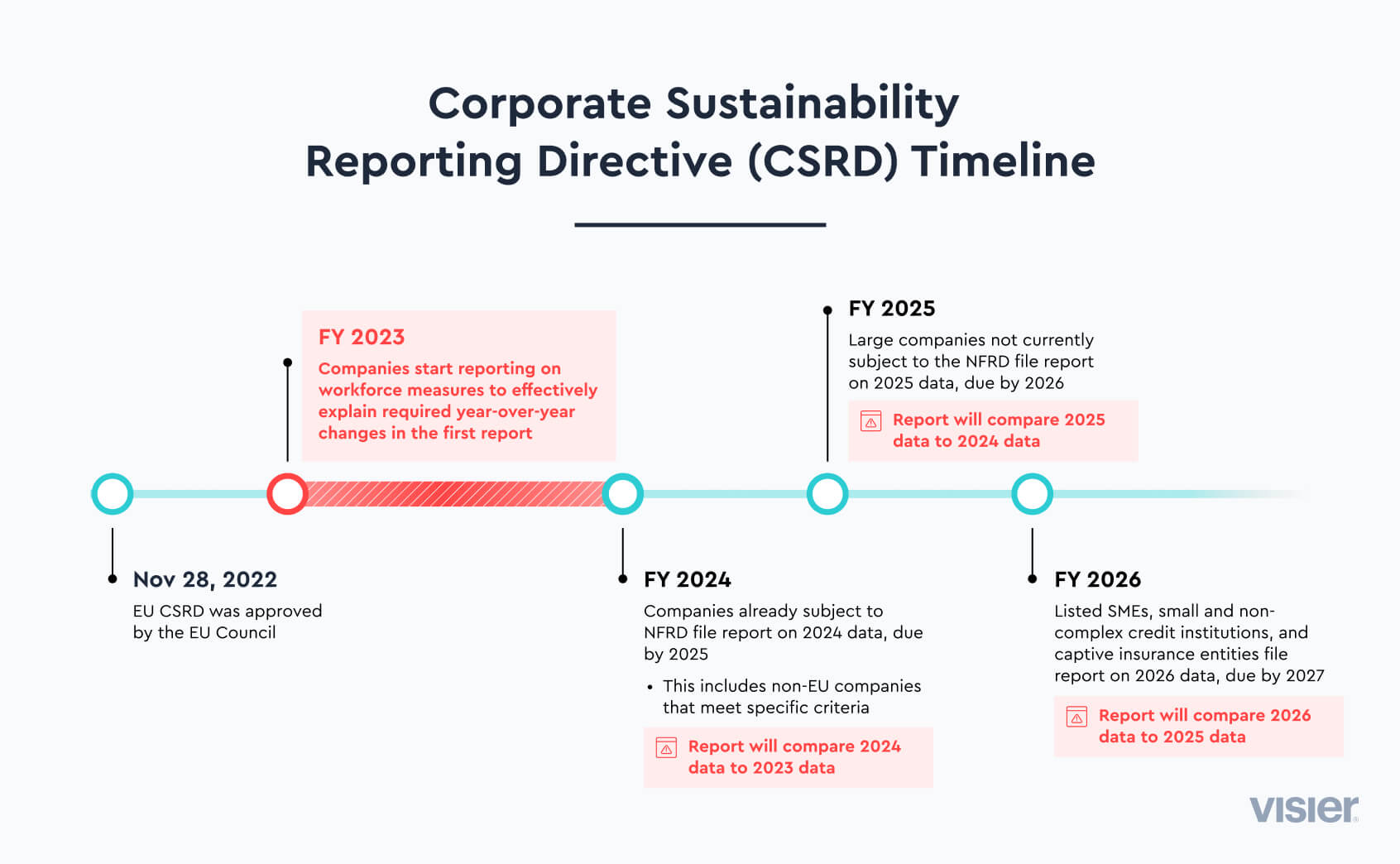What EU Businesses Need to Know About CSRD ESRS S1
The Corporate Sustainability Responsibility Directive (CSRD) has been signed into law, and EU companies must urgently get their people data ready. Learn how.

For over a decade, leading companies have been analyzing their people data to improve business performance. The leaders in the field recognized long ago that there is a connection between people and financial returns and that these insights were crucial to the success of any business. The introduction of the new Corporate Sustainability Responsibility Directive (CSRD) across all EU member states means that every company with more than 250 employees must quickly catch up to the leaders in the people analytics field.

The CSRD has a comprehensive set of standard measures that include the key areas of Environment, Social, and Governance (ESG), which companies must now report annually. A large part of these measures covers the company's workforce. With the first reporting deadline approaching fast and a high level of expertise in data analysis required, CHROs must start prioritizing this work as soon as possible.
CSRD: a new standard for people reporting
As of November 28, 2022, every organization with more than 250 employees operating in the EU must urgently catch up with the leaders and master their people data. On this date, the Corporate Sustainability Responsibility Directive (CSRD) was signed into law. This EU directive will become enshrined in the laws of all member countries within 18 months and carries considerable weight with the possibility of fines up to 10 million euros or 5% of annual revenue.
The CSRD is expected to impact 50,000+ EU companies and approximately 10,400 companies outside the EU. The organizations covered by these new rules need to act now to be ready. The first reports are due in January 2025, covering the calendar year 2024. Many aspects of the reports require a comparison to 2023, including written commentary explaining key changes. Organizations that rely on spreadsheets or traditional reporting tools will struggle to access the data and insights they need to remain compliant.
This means that companies need to be able to cover the required people measures as soon as possible so they can effectively explain changes during 2024 and what this means for their business.

The new directive covers a wide range of reporting areas and is intended to serve regulators and investors. The information will also be made publicly available. Through creating common reporting standards across this set of business factors, the EU aims to improve government and investor decision-making about which companies are best positioned to perform and support results across what is known as the triple bottom line: climate, social, and financial.
How to get started on CSRD-compliant reporting now
For heads of HR, there is a whole section of the reporting standards that will require close attention. Identified as the standards relating to Own Workforce, it adopts the set of measures and reporting requirements laid out in the ESRS-S1, published by EFRAG. Some of the requirements will be very familiar and require explanations of people policies or responses to certain impacts.
However, the new directive also requires reporting for 30+ different people metrics. Each reported metric needs to be supported by explanatory text that provides context on the results, what has contributed to the results and any responses, and adjustments that the company is taking in response to the results. Compliance requires a more integrated corporate reporting approach across the HR, ESG, finance, and investor relations function—and data-driven HR leaders are well-poised to lead the charge.

Some of these measures are straightforward and should be simple for any organization to produce. For example, there are detailed requirements around headcount and FTE reporting, broken down by country, gender, employment type, and working hours.
But the more urgent aspect of these new reporting requirements is the need to provide written explanations about what is causing changes to the reported numbers. Simply reporting a metric is relatively easy, but understanding how and why that number changes requires much more time and expertise.
Other measures are very complex and require sophisticated modeling and judgment to implement and interpret. For example, the annual compensation ratio compares the direct compensation of the highest-paid person in the company with the direct compensation of the median employee. The ratio shows how many times the median employee’s direct compensation needs to be multiplied to match the highest-paid individual. A ratio of 10 means the highest-paid person earns 10 times the pay of the median employee. At Visier, we now include this measure as part of the expert content that comes with Visier People and have firsthand knowledge of all of the challenges.
Where this measure gets complex is in trying to ensure that the pay items used to generate the direct compensation for each employee, including the highest-paid person, meet the requirements of the law. To find the median employee, a company will need to apply the standard across all employees—permanent, temporary, etc.—which will likely involve a mix of salaried and hourly paid, as well as individuals who are eligible for bonuses and other cash benefits, etc. It is quite common for a payroll file to have codes for 30-40 discrete pay elements. In fact, we’ve seen payroll files with over 200 discrete pay codes!

Having mastered this mass of data, you then need to ensure that the treatment of the highest-paid individual from a compensation perspective also follows the directive. Often senior leaders receive substantial elements of their direct compensation through incentives and other variable pay mechanisms. Calculating the final ratio of this measure is straightforward. However, if the preparation work to determine what should and should not be included in everyone’s pay measures is not carefully done and tested, it could lead to an outcome that is hard to explain and is an inaccurate representation of your company.
Visier People® Workforce CSRD consolidates the workforce disclosures into a single solution, allowing HR leaders to quickly measure key ESG metrics, drill into specific business units and locations, and glean the insights necessary to explain the what, how, and why behind each.
This is just the beginning
The recognition that people are essential to business success, which has been growing since the turn of the century, took a quantum step forward in 2022. The introduction of the CSRD sets a new standard for the depth and specificity with which companies need to account for their people and their impact on the climate.
The repercussions of non-compliance mean there is no time to delay in getting started. This new legislation puts people and climate impacts on the same level as financial reporting—bringing with it the elevation of the role that HR leaders play in helping companies effectively navigate to success. Working with, and learning from, the leaders who have pioneered this area of practice is a smart way to get started.

Learn more about CSRD ESRS S1 reporting
ESRS S1 "Own Workforce" is a set of reporting disclosures included in the EU CSRD.
Get the scoop about what EU businesses need to know re: EU CSRD ESRS S1.
Workforce reporting requirements in CSRD will increase transparency amongst C-level executives, internal employees, and external stakeholders. Here's what executives need to know.
The EU CSRD Own Workforce standards elevate the importance of people data in the corporate world, introducing a set of mandatory reporting requirements and increasing HR's strategic impact on the business. Seize the opportunity to make a difference.


